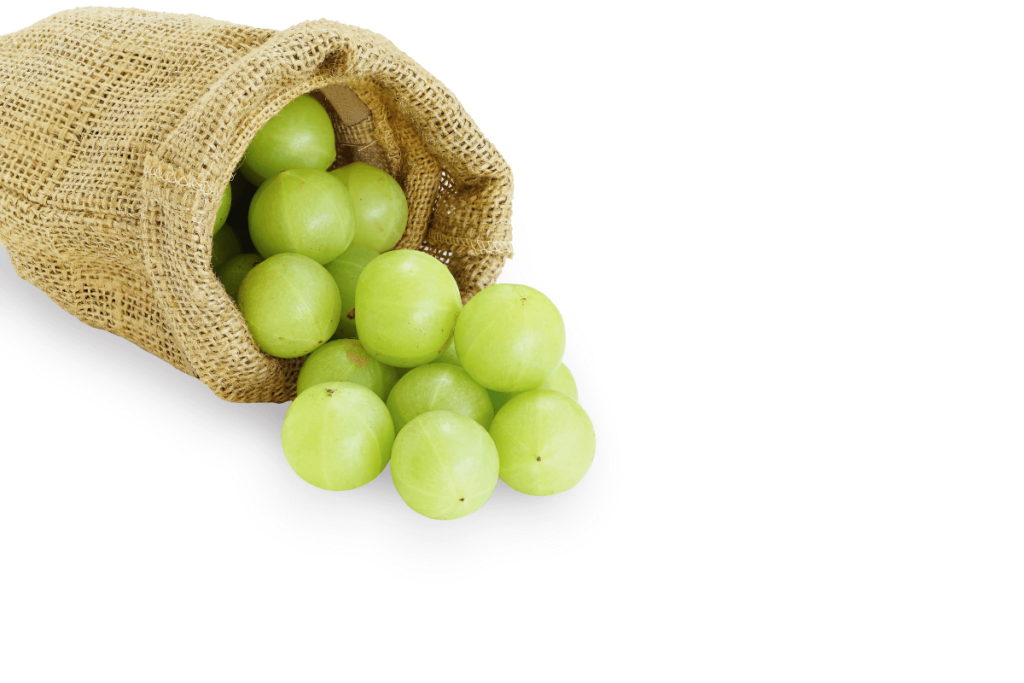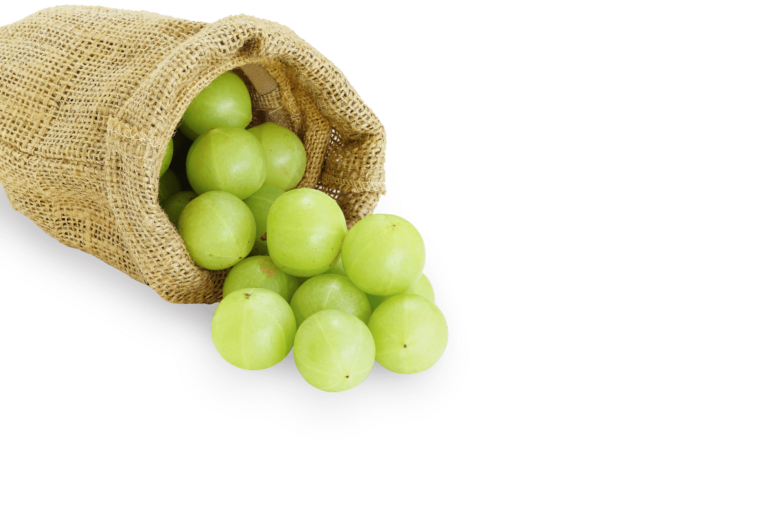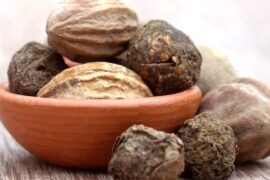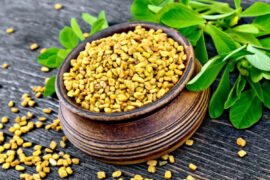Dive into the world of Amla with us as we unravel its myriad benefits, applications, and the science behind its efficacy. Discover how adding Amla to your daily diet can redefine your wellness journey, illuminating the path towards improved blood circulation, enhanced eye health, and regulated blood glucose levels.
The Amla tree grows to a height of 8-18 meters, bearing greenish-yellow flowers and pale-yellow fruits of about 1.3-1.6 cm in diameter. The Amla tree thrives at 22-30°C for sowing and 8-15°C for harvesting, with rainfall between 630-800 mm.
The harvested fruits must be transported quickly to prevent spoilage, and they are often processed into various products like powder, churna, chyawanprash, arista, and sweet preserves.
Revered as a powerhouse of wellness, Amla (Emblica officinalis), also known as the Indian Gooseberry, has been a cornerstone of Ayurvedic medicine for centuries. Often heralded for its remarkable versatility, this humble fruit is far more than what meets the eye. Laden with abundant Vitamin C and brimming with potent antioxidants, Amla is an omnipotent weapon in our battle against numerous health conditions.
Enriched with a high concentration of Vitamin C, the health benefits of Amla are truly manifold. It stands tall as a robust shield against free radicals, significantly maintaining overall health and keeping numerous health conditions at bay. Its antioxidant properties are a beacon of hope for those struggling with oxidative stress. From your heart to your hair follicles, Amla has the potential to nourish every corner of your body, thus contributing to heart health, brain health and promoting hair growth.
Dive into the world of Amla with us as we unravel its myriad benefits, applications, and the science behind its efficacy. Discover how adding Amla to your daily diet can redefine your wellness journey, illuminating the path towards improved blood circulation, enhanced eye health, and regulated blood glucose levels. Let’s unveil the amazing benefits of this Ayurvedic marvel that is Amla, also found in easily accessible forms like Amla powder, Amla extract, and Amla juice. After all, aren’t we all pursuing better health, radiant skin, and lustrous hair?
Let the journey begin!
Amazing Benefits of Amla Powder for Hair

Amla, also known as Indian Gooseberry, is a nutrient-packed fruit widely used in Ayurvedic medicine and beauty products, including those aimed at improving hair health. When used as a powder, Amla offers various benefits for the hair.
One of the notable benefits of Amla powder is its potential to stimulate hair growth. It improves blood circulation to the scalp and may also inhibit certain triggers of hair loss. Limited research indicates that the vitamin E content of Amla may play a role in this hair growth stimulation.
Amla powder can also contribute to hair thickness, reducing premature graying, which is often a concern as we age. It helps combat scalp inflammation and ensure the health of the scalp, which in turn supports the growth and health of hair.
Amla powder’s nutrients also offer protection from UV damage, helping to keep the hair healthy in harsh environmental conditions.
Furthermore, Amla powder can be combined with other herbs or ingredients like oils, eggs, or milk to make a paste or mask, enhancing its effectiveness.
However, while Amla powder offers these benefits, conducting a patch test before regular use is essential to ensure no adverse reactions.
Pregnant or breastfeeding individuals should also consult a doctor before use due to the potent nature of this natural remedy.
How to Use Amla Powder for Hair
Let me introduce you to this fantastic little secret that has been part of the Indian tradition for ages, giving countless people lustrous, healthy hair. Amla, or Indian Gooseberry, is a powerhouse of nutrients and antioxidants that can transform your hair routine, and yes, it comes in a convenient powder form too!
You might wonder, “How do I use this mystical powder?”
Well, that’s precisely what we’re about to discover together. There are numerous ways to incorporate Amla powder into your hair care routine.
I’ll share three fabulous methods with you – Amla hair tea, Amla hair mask, and other ingenious ways to benefit from this age-old remedy.
But first, let’s dive into what makes Amla Powder a hair-care superhero. Amla powder helps improve hair color, prevent hair loss, decrease hair shedding, control dandruff, condition your hair, and promote growth. In other words, it’s like a magic potion that tackles various hair woes at once!
1. Amla Hair Tea
Amla hair tea is a simple and refreshing way to reap the benefits of Amla powder.
- Add a spoonful of Amla powder to hot water, simmer for a few minutes, and then strain it with a cheesecloth.
- Once the tea cools down, use it as a final rinse after washing your hair.
This process helps seal the nutrients in your hair strands and imparts a lovely shine.
An alternative is to use dried amla berries.
- Add one tablespoon of dried amla berries to 200mls of boiling, cover, and let sit overnight.
- Using a dropper, apply the tea to your scalp and massage your scalp for twenty to thirty minutes.
- You can follow up by styling your hair as usual, or you can rinse your hair.
Incorporate this method into your hair care routine twice weekly for the best results
2. Amla Hair Mask
An Amla hair mask is another effective way to give your hair the nourishing treatment it deserves.
- Mix three tablespoons of Amla powder with a hydrating agent such as yogurt or coconut milk to create a thick paste.
- Apply this to your hair and let it sit for 30-45 minutes before washing it off.
Another excellent combination:
- Combine three tablespoons of Amla powder with one tablespoon of aloe vera powder. Mix the dry ingredients and then add aloe vera juice or warm water to make a hair mask the consistency of pancake batter.
- Mix one tablespoon of honey into your Amla hair mask, and voila!
- Apply this mask to wet hair and cover it with a plastic wrap or shower cap. Let it sit for 30-45 minutes before washing it out.
Apply this hair mask once a month to harness the phenomenal benefits of the Amla berries.
These potent masks can condition your hair, fight off dandruff, increase hair density, and promote hair growth.
Other Ways to Use Amla Powder
But why stop there?
Amla powder is versatile and can be incorporated into your routine in several other ways. Mix it with your regular hair oil, let it infuse for a day or two, and then use this concoction for your oil massages. Alternatively, add Amla powder to your shampoo or conditioner for a nutrient boost.
If you are in the mood for a DIY, prepare a gentle Amla hair cleanser:
- Mix two tablespoons of Amla powder with two tablespoons of Shikakai powder and two tablespoons of Ritha powder.
- Add hot water for a runny consistency.
- Mix well and let it cool.
- Add this mixture to an applicator bottle and apply it to your scalp.
- Massage your scalp for 15 minutes, then wash your hair thoroughly with lukewarm water.
Remember, like all good things, using Amla powder for hair benefits takes time. Consistent use over several weeks will yield visible results, so patience is key.
Now that you know the secrets of Amla Powder, it’s time to bring this ancient wisdom into your modern hair care routine. So go ahead, explore the magic of Amla, and say hello to healthier, happier hair!
Related: Exploring the Wonders of Fenugreek: Your Ultimate Herb Guide
How to Prepare Amla Berries – A Guide to Preparing and Preserving
Allow me to take you on a flavorful journey with Amla berries. Amla, or Indian gooseberry, is packed with antioxidants and vitamin C and is a staple in Ayurvedic medicine due to its diverse health benefits. Amla is your go-to superfruit whether you’re interested in boosting immunity, reducing cholesterol, or enhancing digestion.
But how exactly can you prepare it?
Here are three tasty and easy ways to incorporate Amla berries into your diet!
1. Amla Candies and Amla Murabba
If you have a sweet tooth, Amla candies, and Amla Murabba might just be your new favorite treats! Both these recipes are simple, healthy, and a delightful blend of sweet and sour.
The process involves boiling Amla berries, preparing a sugar syrup, and simmering the berries in the syrup until it thickens.
Once cooled, the Amla candies can be air-dried and enjoyed as a sweet snack, while the Amla Murabba can be preserved in sterilized jars.
2. Amla Pickle (Amla Ka Achar)
For lovers of all things spicy and tangy, Amla Ka Achar, an Indian pickle made with raw Amla berries, will tickle your taste buds in all the right ways.
The process includes boiling the Amla berries, grinding traditional Indian spices, and briefly cooking them together.
This pickle is low in oil and avoids garlic or onion, making it a healthier alternative to regular pickles. The best part? It can be preserved for months if stored properly, allowing you to enjoy this spicy delight whenever possible!
3. Raw Juice and Grated Amla
For those who prefer keeping it simple, raw Amla juice or grated Amla in soups and vegetables is your answer. These methods allow you to enjoy Amla in its most natural form, ensuring you get the most of its nutritional benefits.
Remember, the show’s star is Amla, no matter your chosen preparation method. This humble fruit is a powerhouse of nutrients, a treasure trove of health benefits, and a delicious meal addition.
So why wait? Dive into the world of Amla berries and give your health the boost it deserves! Happy cooking!
Amla Health Benefits
Let’s delve into the rich and nourishing world of Amla, a fruit that has captured the attention of health enthusiasts and medical experts alike. With its plethora of health benefits, Amla, also known as Emblica officinalis or Indian gooseberry, has become an integral part of holistic wellness.
Diabetes Control
Amla’s remarkable anti-diabetic properties have been the subject of in vivo and in vitro studies. The fruit’s bioactive compounds show strong potential in managing diabetes by reducing oxidative damage and improving antioxidant status.
What makes it a natural weapon against diabetes?
The synergy of polyphenols, vitamin C, and antioxidants works together to control blood sugar levels.
Can Amla be the next big thing in diabetes management? More research is needed, but the current findings are certainly promising.
Better Digestion
Digestion is the cornerstone of good health, and Amla has a powerful impact on the digestive system. The gastroprotective effects of Amla contribute to improving digestive processes.
But what exactly does this mean for you?
Imagine having a natural remedy that not only aids in digestion but also protects your digestive system. Whether it’s a daily supplement or an integral part of your meal, Amla can be that gentle push toward better digestive health.
Healthier Eyes
Amla’s high antioxidant content can indirectly contribute to overall eye wellness. Antioxidants play a crucial role in maintaining eye health by fighting oxidative stress. Remember the old saying, “You are what you eat”?
Amla might be a wise addition to your diet to keep those eyes sparkling.
Memory and Brain Health
Here’s something to ponder: Could a fruit enhance your memory and brain health?
Amla exhibits neuroprotective properties, which means it can potentially protect the neurons in your brain. What if incorporating Amla into your diet could be your shield against neurodegenerative diseases?
Though it’s too early to make definitive claims, the thought alone is exciting and prompts further exploration.
Immunity
In a world where immunity has become a buzzword, Amla stands tall with its immunity-boosting capabilities. Rich in vitamin C and antioxidants, it helps fight the common cold and enhances the body’s ability to ward off various diseases. Have you ever considered how something as simple as a fruit could become your ally in staying healthy?
Well, Amla does just that. It’s not just a fruit; it’s a reservoir of wellness.
Lipid and Cholesterol Control
The power of Amla, scientifically known as Phyllanthus emblica, to combat high cholesterol is backed by significant research and studies. Its rich composition of polyphenols and vitamin C is not the only reason why it has become a popular ingredient in the health and wellness industry, but also due to its profound antioxidant properties1. But what makes Amla, or Indian Gooseberry as it’s affectionately known, an effective combatant against high cholesterol?

Studies have attributed the potent biological effects of Amla to its low-molecular-weight hydrolyzable tannins. These components aren’t just a mouthful in terms of terminology but also pack a punch regarding health benefits. Amlamax, a purified standardized dried Amla extract, is a prime example, containing around 35% of galloellahi tannins and other hydrolyzable tannins.
When it comes to empirical evidence, animal studies have shown the incredible capabilities of Amla. One such study noted the prevention of age-related hyperlipidemia through the attenuation of oxidative stress in the aging process in rats. However, Amla isn’t just beneficial for our furry friends. Its benefits extend to humans as well.
A human study that evaluated healthy volunteers who consumed 500-1000 mg of Amlamax daily for six months revealed a decrease in total LDL-Cs, often called “bad cholesterol,” and CRP, an inflammatory marker. Notably, there was an increase in HDL-C, known as the “good cholesterol.” These findings highlight the potential role of Amlamax in the prevention and risk reduction of Cardiovascular Diseases (CVD).
But let’s dive deeper, shall we? Another trial focused on men aged between 35 and 55, who were given raw Amla berries daily for four weeks. It was noted that there was a decrease in total cholesterol levels, a win for heart health!
However, these levels returned to baseline once the consumption of Amla was withdrawn. This result suggests the need for consistent intake of Amla to maintain its cholesterol-lowering effects.
Research has also shown the antihyperglycemic and lipid-lowering properties of Amla. On the 21st day of Amla supplementation, diabetic subjects witnessed a decrease in fasting and postprandial blood glucose levels. A reduction in total cholesterol and TGs, LDL-C levels, and an increase in HDL-C levels were also observed.
Even in combination with other potent herbs like Terminalia Chebula, Terminalia Belerica, and E. Officinalis, Amla demonstrated hypolipidemic effects in hypercholesterolemic rats in a formulation known as Triphala. A 45-day supplementation with Triphala powder showed decreased blood glucose levels in type 2 diabetics.
Related: The Power of Ashwagandha: Benefits, Side Effects, and Uses
Amla Nutrients per Serving
Amla, or as you might know it, Indian Gooseberry, is quite the powerhouse when it comes to nutrients. Even by calling it a “superfruit,” you’re just scratching the surface of this marvelous little green globe of goodness.
Curious to know what it has in store? Well, let me spill the beans – or should I say berries?
For starters, think about a fresh, tangy orange.
Now multiply its vitamin C content by eight. That’s right; one single Amla has up to eight times more vitamin C than an orange!
Let me paint a more vibrant picture if that doesn’t quite click. Imagine you’ve gathered 20 oranges in your basket. Now, replace that with just 100 grams of Amla berries. That’s the same amount of vitamin C! An impressive feat, isn’t it? But the nutrient richness of Amla doesn’t stop there. This superfruit isn’t just about vitamin C. It brings to the table a buffet of other essential nutrients as well. Vitamins A and E are all part of its menu. You’ll also find a generous serving of minerals like iron and calcium. Amla is not just about packing a punch; it’s about providing a balanced, nutritional hit.
And what about using this wonder berry, you ask? The options are as diverse as the nutrients it houses. Its versatility would put a chameleon to shame! Fresh juice to kickstart your morning, dried Amla for a tangy snack or even pickled to add an exotic twist to your meals. From Amla chutney to Amla Sabji, this superfruit can be a culinary delight, all while delivering its extensive health benefits.
Just one word of caution, though – while this berry is, without a doubt, a nutritional superstar, don’t treat it as a magic cure-all. No fruit can replace a balanced diet and good medical advice. It’s best to consult your healthcare professional if you’re considering any major dietary changes.
So, next time you see this humble green berry, remember it’s not just a fruit; it’s a mini-nutrient factory. Amla is here to serve a hearty helping of health, one bite at a time!
Amla Side effects and precautions
Amla or Indian Gooseberry is a treasure trove of benefits. From providing a potent doses of vitamin C to supporting overall wellness, it’s a superfruit in every sense. But, as the old saying goes, even roses have thorns. While Amla is mostly benevolent, some sides to this fruit must be taken with a pinch of salt.
A little thing about nature – it doesn’t create a one-size-fits-all solution. What works for one might not work for another. And Amla is no exception. For some, it could lead to potential allergic reactions. Now, this doesn’t mean you’ll start sneezing at the sight of Amla. Allergic reactions could present themselves in various ways, perhaps as a rash or an upset stomach. It’s important to be mindful of any unexpected reactions when introducing any new element to your diet, Amla included.
And speaking of stomachs, let’s talk about consumption. As tempting as it might be to load up on this nutrient powerhouse, remember, too much of a good thing can quickly turn bad. Overconsumption of Amla can tip the scale towards unwanted side effects. So, while it’s a good idea to incorporate Amla into your diet, remember to do so in moderation. Balance is key.
Another point of concern is medication interactions. If you’re on prescribed medication, it’s crucial to consult with your healthcare provider before bringing Amla into your dietary regimen. Amla could interact with your medication, altering its effectiveness.
As much as we adore our superfruits and their myriad benefits, we must be mindful of the potential side effects and precautions.
Remember, balance, moderation, and a good dose of common sense are the key to deriving the most from our diet. After all, as the adage goes, an ounce of prevention is worth a pound of cure!
Amla FAQ
What is Amla?
Amla, also known as Indian Gooseberry, is a potent medicinal fruit. It is rich in vitamin C, antioxidants, and polyphenols and offers various health benefits.
How does Amla benefit health?
Amla supports many aspects of health, including managing hypertension, diabetes, improving digestion, mental health, weight loss, hair growth, and volume. Its high vitamin A content also benefits eye health.
How is Amla used in Ayurvedic treatments?
Amla can be used in various Ayurvedic treatments for the liver, hair, and more. It has potential benefits in weight loss, anti-cancer, and diabetes treatment. Amla’s polyphenols, chromium, and insulin-stimulating properties contribute to its anti-diabetic effects.
How can Amla be consumed?
Amla can be consumed in various forms, such as fresh fruit, dried, powdered, made into juice, oil, and candy, or used in recipes like fry, curry, murabba, rice, and tikki.
What are the nutritional components of Amla?
Amla is high in Vitamin C, antioxidants, and fiber, making it a great immunity booster, aiding digestion, promoting weight loss, lowering cholesterol, and preventing inflammation and cancer.
Does Amla have any side effects?
Yes, despite its many health benefits, Amla does have some limitations. These include possible interactions with medications, potential allergic reactions, and overconsumption leading to side effects.
What are the benefits of Amla for hair growth?
Amla aids in enhancing hair growth and volume. It can also be used in various hair treatments in Ayurveda.
How does Amla support mental health?
Amla supports mental health, possibly due to its rich content of antioxidants and polyphenols, which have been known to have neuroprotective effects.
Can Amla aid in weight loss?
Yes, Amla aids in weight loss. Its high fiber content helps maintain a healthy metabolism, which aids in weight loss.
Does Amla have any anti-aging properties?
Yes, Amla has anti-aging properties, largely due to its high antioxidant content, which combats free radicals responsible for aging and cellular degeneration.









